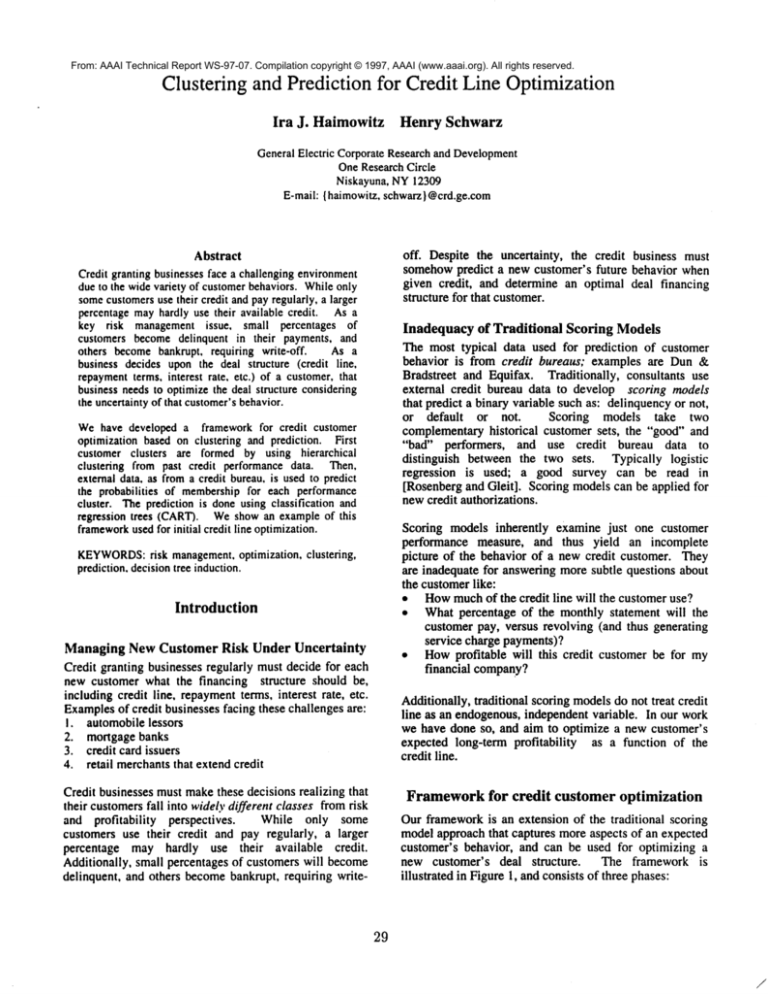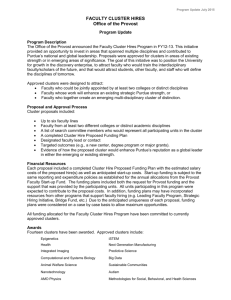
From: AAAI Technical Report WS-97-07. Compilation copyright © 1997, AAAI (www.aaai.org). All rights reserved.
Clustering and Prediction for Credit Line Optimization
Ira J. Haimowitz Henry Schwarz
General Electric CorporateResearch and Development
OneResearchCircle
Niskayuna, NY12309
E-mail: { haimowitz,schwarz} @crd.ge.com
off. Despite the uncertainty, the credit business must
somehowpredict a new customer’s future behavior when
given credit, and determine an optimal deal financing
structure for that customer.
Abstract
Credit granting businesses face a challengingenvironment
due to the widevariety of customerbehaviors. Whileonly
somecustomersuse their credit and pay regularly, a larger
percentage mayhardly use their available credit. As a
key risk management issue, small percentages of
customers becomedelinquent in their payments, and
others becomebankrupt, requiring write-off.
As a
business decides uponthe deal structure (credit line,
repaymentterms, interest rate, etc.) of a customer,that
business needsto optimizethe deal structure considering
the uncertaintyof that customer’sbehavior.
Inadequacy of Traditional
Scoring Models
The most typical data used for prediction of customer
behavior is from credit bureaus; examples are Dun &
Bradstreet and Equifax. Traditionally, consultants use
external credit bureau data to develop scoring models
that predict a binary variable such as: delinquency or not,
or default
or not.
Scoring models take two
complementary historical customer sets, the "good" and
"bad" performers,
and use credit bureau data to
distinguish between the two sets. Typically logistic
regression is used; a good survey can be read in
[Rosenberg and Gleit]. Scoring models can be applied for
new credit authorizations.
Wehave developed a framework for credit customer
optimization based on clustering and prediction. First
customer clusters are formed by using hierarchical
clustering from past credit performance data. Then,
external data. as froma credit bureau, is used to predict
the probabilities of membershipfor each performance
cluster. The prediction is done using classification and
regression trees (CART).Weshow an example of this
framework
used for initial credit line optimization.
Scoring models inherently examine just one customer
performance measure, and thus yield an incomplete
picture of the behavior of a new credit customer. They
are inadequate for answering more subtle questions about
the customer like:
¯
Howmuchof the credit line will the customer use?
¯
What percentage of the monthly statement will the
customer pay, versus revolving (and thus generating
service charge payments)?
¯
Howprofitable will this credit customer be for my
financial company?
KEYWORDS:
risk management,optimization, clustering,
prediction, decisiontree induction.
Introduction
Managing New Customer Risk Under Uncertainty
Credit granting businesses regularly must decide for each
new customer what the financing structure should be,
including credit line, repaymentterms, interest rate, etc.
Examplesof credit businesses facing these challenges are:
I. automobile lessors
2. mortgage banks
3. credit card issuers
4. retail merchants that extend credit
Additionally, traditional scoring modelsdo not treat credit
line as an endogenous, independent variable. In our work
we have done so, and aim to optimize a new customer’s
expected long-term profitability
as a function of the
credit line.
Credit businesses must makethese decisions realizing that
their customersfall into widely different classes from risk
and profitability
perspectives.
While only some
customers use their credit and pay regularly, a larger
percentage may hardly use their available credit.
Additionally, small percentages of customers will become
delinquent, and others becomebankrupt, requiring write-
29
Framework for credit customer optimization
Our frameworkis an extension of the traditional scoring
model approach that captures more aspects of an expected
customer’s behavior, and can be used for optimizing a
new customer’s deal structure.
The framework is
illustrated in Figure 1, and consists of three phases:
Newcredit applicant,with
er~tqrna~
~ureau
dqta
®
:
Delinquency
ss"
s
Spending
¯ ¯
"~
**.
+ Pr(cluster K) * Exp(NPVI cluster K,V)
Where Exp(NPVI V) is the expected dollar net present
value for a customer with deal vector (including credit
line) V.
Pk~ ". ~’.
While there is no guarantee that this overall expected net
present value will have a unique maximum, we have
found unique optima in practice for optimizing against the
one deal variable of initial credit line. That application is
the subject of the rest of this paper.
Revolving
Y
Figure 1: Clustering-based frameworkfor optimizing a
credit policy.
1.
2.
3.
Exp(NPV IV)
Pr(cluster I) * ExpfNPV
I cluster 1,
+ Pr(cluster 2) * Exp(NPV
I cluster 2,
Application:
Clustering and Curve Fitting
Prediction of Cluster Probabilities
Optimization Model
In phase 1, historical accounts are clustered into K groups
based on manymonths of performance data that account
for the customers’ patterns of spending and paying bills.
The rationale for the clustering is to divide the historical
accounts into their different behavior patterns. Preferably,
each account should include monthly observations from
the beginning of the account until a fairly long
performance period. This allows delinquent and bankrupt
accounts to reach those undesirable states. In practice, we
have found 21 or more months as a suitable time horizon.
Within each cluster,
a curve is fit that maps the
relationship between the deal structure variables and the
expected net present value (NPV)to the credit company.
NPVwill be described more in section 3.
In phase 2, decision tree induction, in the form of
regression trees, is used to predict the probability of
cluster membershipfor new accounts. The decision tree
induction uses old external credit bureau data for the
historical accounts, using a snapshot of the time those
accounts were applying for credit. The particular decision
tree used is CART,for Classification
and Regression
Trees [Breiman et. al.], which is part of the S-Plus
statistics package. The output of the decision tree is a set
of rules, with each rule predicting K probabilities, Pl to Pk,
of membershipin each of the K clusters.
Credit
Line Optimization
Wehave applied this modeling framework to optimizing
the initial credit lines for newcustomers, a typical project
within financial risk managementof credit companies.
Credit line assignment is a risk managementissue for two
primary reasons:
1. Customersthat write-off tend to do so close to their
credit limit
2. Unusedcredit line is excess "exposure" for a credit
company, which is highly discouraged because a
customer may in hard financial times becomerisky.
To protect business confidentiality, we describe the main
qualitative results while omitting the specific data
attributes
use and the financial dollar amounts. We
divided our roughly 82,000 accounts into training and
validation sets based on the time of initial credit
application. The 55,000 accounts applying for credit in
October and November 1993 were the training set; the
27,000 applying for credit in December 1993 were the
holdout set. This experimental design let us test the
model’s predictive ability.
Cluster Descriptions
The attributes used in clustering the credit customers were
related to:
¯
Spending patterns over 21 months
¯
Patterns of paying monthlybills.
¯
Usageof the credit line.
¯
Other risk related attributes.
First a random 10%sample was taken, and hierarchical
clustering performed (which has run time of O(N2) for N
accounts).
The optimal number of clusters was
determined from distance changes in the resulting
dendrogram. After comparing results with two random
samples, we determined that 5 clusters was best. Then,
we used the five cluster centers as inputs in a K-means(or
iterative nearest neighbor) clustering (which has run time
of O(N)) on all of the 55,000 observations. K-means
In phase 3, the optimal deal structure for a new customer
is determined by maximizing the overall expected net
present value of a customer over all values of that deal
structure. The overall net present value is computed as
follows, say for optimizing a deal vector V:
30
NPV
run for 1,000 iterations, or until convergence.
The five clusters are listed here with their general
characteristics:
I. Usually on time with payments, pay most of their
monthlybalance, use someof their credit line, fairly
high sales, and fairly profitable.
2. Fairly delinquent accounts, pay someof their monthly
balance, high sales, and very profitable. Should be
treated with caution in times of recession.
3. Ontime with payments,but very little sales activity.
Not very profitable.
4. Very delinquent; all of these are write-offs. Generate
fairly high sales but are unprofitable. Creditors lose
moneyon these.
5. Mixture of on-time and delinquent accounts, generate
high sales, and are very profitable, especially at lower
credit lines.
Net Present Value Relationships Within Clusters
The net present value (NPV)of an investment is defined
as the net income that investment generates, with future
income discounted to the time of the original investment.
Net present value is often used by corporations in
budgeting capital investments [Brealy and Myers], and is
recommended as a good quantitative
measure of the
success of a targeted marketing campaign [Hughes]. NPV
is also a natural measure of the profitability
of an
individual customer, such as a catalogue recipient [Bitran
and Mondschein]. Another example is a long-term credit
customer, because that customer’s monthly payments are
likely to last over a period of several years.
An NPVcalculation
is dependent on the financial
application, and generally includes both expenses and
revenue. Expenses include the cost of acquiring the
account, cost of mailing bills, and written-off dollars from
unpaid balances. Revenue includes payments of bills
received and service charges received.
In this example, we have examined the relationship
between initial credit line and NPVfor accounts within
each of the five clusters. The relative relationships are
illustrated
in Figure 2. Each graph was determined by
plotting the truncated mean NPVfor the accounts
receiving that initial credit line. The plots were then
smoothed by Loess curve fitting. Clusters 1 and 2 are
more valuable with increased credit lines, with a plateau
at higher lines. Cluster 3 showslittle profitability for any
credit line. Cluster 4, consisting entirely of write-off
accounts, shows negative and decreasing NPV for
increasing credit lines. Cluster 5 increases in profitability
for lower accounts, then decreases for higher accounts as
the write-off and delinquent effect overcomes the
profitable effect. As can be seen from these bivariate
relationships, modelingat the individual cluster level can
be more accurate than at the overall population level.
31
O~im~Z-al
NPV
1
NPV
2
3
l_ine
0
Ini~al
Line 0
NPV
NPV
4_
0
Ini ffal Line
Figure 2: Models of Net Present Value versus initial
credit line for five historical clusters.
CARTRule Results
The CARTanalysis linked external credit bureau data
from the time of credit application to the cluster numbers
for all 55,000 accounts in the training set. Thus the
decision tree induction predicted the probability of cluster
membership for credit accounts in this population. The
CARTanalysis produced 17 rules, with probabilities
summarizedin the table below. For example, the first rule
says that if various credit variables are above or below
particular thresholds then the probabilities of membership
in the 5 clusters are: (0.24690 0.4599 0.2229 0.043050
0.027250). Probabilities are estimated as the frequencies
of membership in each of the 5 clusters, divided by
numberof observations meeting that rule’s criteria.
Note in particular that rules 5 and 7 have relatively high
probabilities
of cluster 4 membership. This cluster
consists entirely of write-offs. Thusrules 5 and 7 indicate
high risk conditions. Rules 10, 13, 14, 16, 17, on the
other hand, have relatively low probabilities of cluster 4,
indicating low risk conditions. Note also that the highrisk rules also have fairly high membershipin cluster 2
(profitable but often delinquent), whereas the low-risk
rules have low membershipin cluster 2.
Using these CARTrules, new cardholder accounts are put
into one of 17 bins. which has an impact on the optimal
initial credit line for that account. The CARTrules were
validated using the holdout sample, by comparing the
probabilities
of cluster memberships for each rule’s
criteria in the validation set versus those in that rule.
1
2
3
4
5
6
7
8
9
10
11
12
13
14
15
16
17
0.242
0.075
0.144
0.178
0.071
0.122
0.019
0.183
0.138
0.248
0.247
0.291
0.322
0.314
0.211
0.259
0.349
0.451
0.532
0.525
0.498
0.595
0.598
0.534
0.592
0.560
0.490
0.433
0.427
0.356
0.363
0.532
0.484
0.441
0.229
0.277
0.227
0.273
0.159
0.199
0.189
0.152
0.212
0.212
0.254
0.234
0.286
0.298
0.190
0.198
0.181
0.050
0.078
0.058
0.024
0.109
0.043
0.106
0.035
0.044
0.020
0.035
0.021
0.008
0.012
0.028
0.018
0.012
Table 1: Cluster membershipprobabilities
CARTrules.
determine the size and timing of credit line changes as
customer behavior is observed. The existing framework
can be extended to handle the dynamic problem by using
Bayes’ Rule to update the membership probabilities.
Specifically, equation 1 below can be used to update the
probability of being in cluster c given observed behavior
x, where x is a vector of discrete performance measures
(say, spending patterns and paymentbehavior):
0.027
0.037
0.046
0.026
0.066
0.038
0.062
0.037
0.046
0.030
0.032
0.027
0.027
0.012
0.038
0.040
0.017
(1) P(c I x_)=P(_xI c)*P(c)/P(,x_)
Here, P(x_) and P(x_ I c) are estimated from the historical
data. A Bayesian approach requires that the multivariate
distributions P(x_) and P(x_ I c) be specified. Choosing
suitable family of multivariate distributions in this case is
difficult for a numberof reasons. First, the performance
measures comprising x are not independent, nor are they
of like type. Somemeasures may be integer (i.e. number
of months delinquent), while others are continuous.
Additionally,
there is reason to believe that the
distribution of x__ is time dependent. This is clearly the
case when delinquency is a part of x__. Lastly, visual
inspection of some spending measures reveal highly nonnormal distributions.
for the 17
Initial Line Optimization
For each new credit card applicant, we calculated the
expectedNPVat each initial credit line CLas follows:
Exp(NPVI CL)
Pr(Cluster 1)* Exp(NPV
I Cluster 1,
+ Pr(Cluster 2)* Exp(NPV
I Cluster 2,
+ Pr(Cluster 3)* Exp(NPV
I Cluster 3,
I Cluster 4,
+ Pr(Cluster 4)* Exp(NPV
I Cluster 5,
+ Pr(Cluster 5)* Exp(NPV
Using this weighted average formula, we calculated the
expected NPVat a variety of initial credit lines. The
optimal credit line for a given rule is that with the
maximumNPV;a unique optimum existed for each rule,
with no distinct local optima. Wedon’t showthe detailed
lines here; the highest lines were 67%higher than the
lowest lines. The accounts in the higher risk rules (5 and
7) were assigned lower lines, whereas those in lower risk
rules are assigned higher lines.
Conclusions and Future Work
Wehave presented a framework for credit customer
optimization based on clustering and prediction. This
frameworkis flexible in allowing various schemes. Other
segmentation methods are possible, as well as other
prediction techniques (such as neural networks). Below
we describe other ways the basic framework may be
extended.
For these reasons, we propose calculating the empirical
distribution of _x_ for various account ages t (in months),
say t = 4, 8, 12 ..... 32. Wepropose discretizing x by
binning the constituent
performance measures (i.e.
spending and payment measures) at appropriate levels. If
x_ comprises three performance measures with four levels
each, then there would be 43 = 64 discrete values of x.
The more levels of each measure, the more data are
required to accurately estimate P(x_) and P(x__I c). In fact,
this approach is subject to the explosion of dimensionality
present in manytechniques involving the discretization of
continuous variables. The main problem is the amount of
data to estimate P(x_ I c). However,the above scenario
64 discrete values of _x is reasonable given the large size
of manycustomer databases.
GivenP(x__) and P(x I c) at time t, equation (1) can be
to obtain an updated estimate of the probability of cluster
membershipfor all clusters. In the above paragraph, we
suppose that these probabilities would be updated every
four months until an account is 32 months old. The
updated membershipprobabilities would used as before to
determine the new optimal credit line. If the new optimal
credit line differs from the current line, then the
appropriate line change would be recommended.
Extension to higher dimensions
Wehave demonstrated credit account optimization as a
function of one independent variable, the initial credit
line. However, one maywish to optimize credit line as a
function of multiple independent variables, such as
repaymentterms, interest rates, etc.
Extending the Approach to Managing Credit
Lines Over Time
The assignment of initial credit lines does not solve the
entire business problem.
There is still a need to
32
In principle,
our same clustering
and prediction
frameworkapplies, but the challenges are in finding the
optima of a multidimensional input space. The optima is
unlikely to be unique, and there maynot be sufficient data
to accurately represent the entire space. These limitations
may be overcome using search and optimization
techniques in data-rich domains.
References
Bitran, G.R., and Mondschein, S.V., "Mailing Decisions
in the Catalog Sales Industry," ManagementScience,
v.42. no.9, September 1996, pp.1364-1381.
Brealy, R.A., and Myers. S.C., Principles of Corporate
Finance. fourth edition,_Mc-GrawHill, 1991.
Breiman, L., Friedman, J.H., Olshen, R.A., and Stone, C.
J., Classification and Regression Trees. Chapman&Hail,
1993.
Hughes, A. M., "Lifetime Value, the Criterion of
Strategy," chapter 3 of Strategic Database Marketing,
Irwin Professional Publishing, 1994.
Rosenberg, E. and Gleit, A., "Quantitative Methods in
Credit Management: A Survey," Operations Research.
v.42, n. 4, July-August 1994, pp. 589-613.
Acknowledgments
Bill Hunt, Michael Koukounas, Brian Murren, and
Junjie Xiong of General Electric have all provided
valuable effort on this project and this paper. Margaret
Trench of General Electric has been especially supportive.
33








